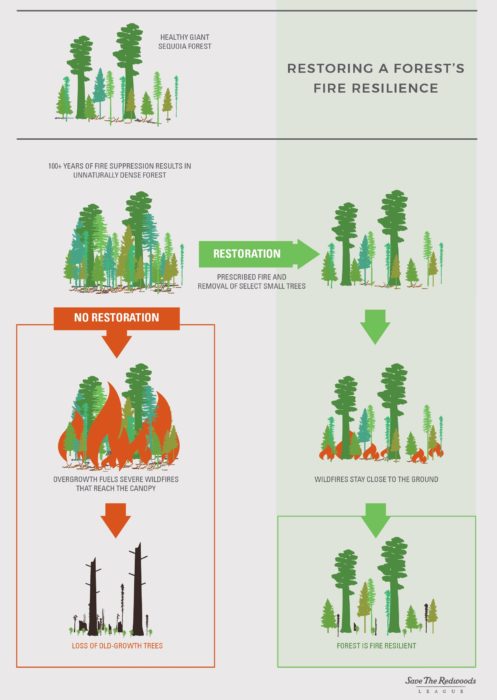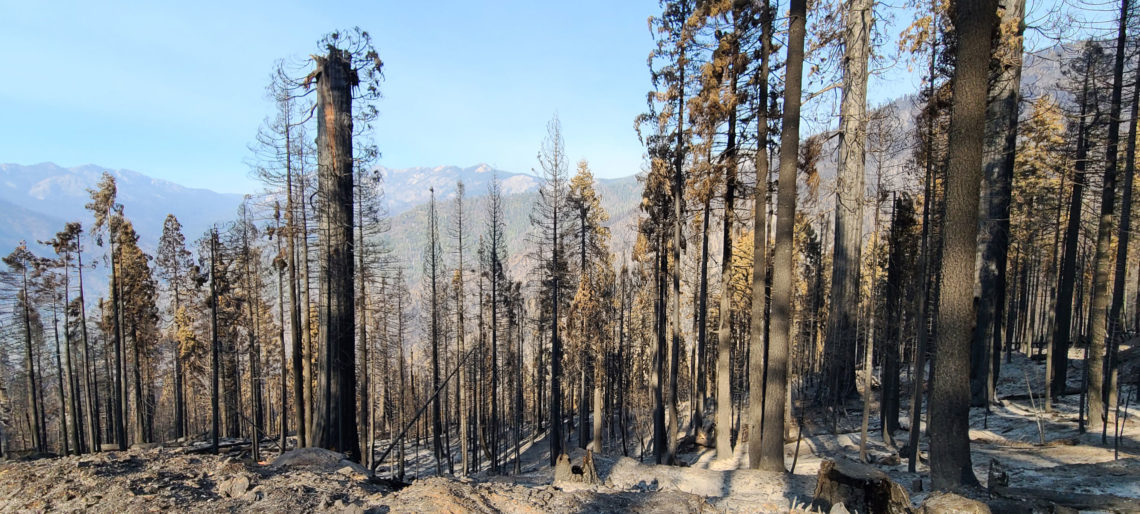Reviewing the science behind wildfire management
All the work being done by the League and its partners in the giant sequoia range to protect the forests from high-severity wildfires is based on the broad consensus of scientific research. Nonetheless, a great deal of confusion exists in the media and elsewhere about both the threat that high-severity fire presents and what, if anything, should be done about it. We share the following statements of fact, along with citations from academic research, in the hope of dispelling misconceptions.
The following is adapted, with permission, from Counteracting Wildfire Misinformation, published in the September 2022 issue of Frontiers in Ecology and the Environment by Gavin M. Jones, Emily K. Vraga, Paul F. Hessburg, Matthew D. Hurteau, Craig D. Allen, Robert E. Keane, Thomas A. Spies, Malcolm P. North, Brandon M. Collins, Mark A. Finney, Jamie M. Lydersen, and A. Leroy Westerling. (Full citations to referenced studies are at the bottom of the page)
Contemporary wildfires are not normal
Contemporary wildfires are abnormal in many ecosystems; those burning in seasonally dry forests are far outside the historical range of variation because of >100 years of fire suppression (leading to buildup and increased landscape continuity of fuels) and climate change, generally burning at a higher severity, in larger patches, and over larger areas.
Forests will not always naturally recover from high-severity wildfires
Without intervention, many forests will convert to non-forest due to disturbances and climatic warming, unable to naturally recover after high- intensity fires due to inadequate conifer seed availability, failed conifer regeneration, worsening site climate, elevated fuel loads and connectivity from fire exclusion, cyclic reburning, and post-fire dominance of shrubs and grasses. Under rapid climate change, natural recovery processes cannot maintain natural fire and ecosystem processes; appropriate interventions can make many forests more resilient to the effects of climate change or incrementally facilitate some inevitable transitions to non-forest.

Fuels reduction treatments are proven to work
There is abundant evidence that forest fuel treatments work, particularly those using fire itself, whether prescribed or managed. Such treatments moderate the behaviors of wildfires, even under extreme weather, slowing their spread, lowering fireline intensity, and reducing severity and smoke production in treated areas. Fuel treatments are appropriate in systems that were historically fuel-limited, and in those high severity systems that currently lack typical burned and recovering patchworks of forest and non-forest.
Fuels reduction is not a Trojan horse for commercial logging
Mechanical fuels reduction focuses on retaining medium and large-sized fire-tolerant trees, to foster their survival of the next fire. Fuels reduction treatments restructure and remove woody material and fuel ladders that built up during fire exclusion, and are often of limited economic value. In other cases, removal of medium-, or large-sized fire-intolerant trees that recruited during fire exclusion is essential to improve fire-tolerant tree survival. The catchphrase “fuels reduction logging” deceptively conflates two very different types of forest management.
Contemporary high-severity wildfires are not beneficial to wildlife
Changing fire regimes pose serious threats to the persistence of numerous native wildlife populations. The massive scale of stand-replacing patches typifying contemporary “megafires” homogenizes landscapes, reduces overall faunal species richness, and eliminates critical habitat for even fire-dependent forest species. Forest wildlife require the long-term persistence of a substantially forested landscape mosaic, as it adapts to climate change and the variability of the fire regime that emerges.
Referenced studies:
Davis KT, Dobrowski SZ, Higuera PE, et al. 2019. Wildfires and climate change push low-elevation forests across a critical climate threshold for tree regeneration. P Natl Acad Sci USA 116: 6193–98.
Falk DA, Heyerdahl EK, Brown PM, et al. 2011. Multi-scale controls of historical forest-fire regimes: new insights from fire-scar networks. Front Ecol Environ 9: 446–54.
Hagmann RK, Hessburg PF, Prichard SJ, et al. 2021. Evidence for widespread changes in the structure, composition, and fire regimes of western North American forests. Ecol Appl 31: e02431.
Hessburg PF, Agee JK, and Franklin JF. 2005. Dry forests and wildland fires of the inland Northwest USA: contrasting the landscape ecology of the pre-settlement and modern eras. For Ecol Manage 211: 117–39.
Hessburg PF, Charnley S, Gray AN, et al. 2022. Climate and wildfire adaptation of inland Northwest US forests. Front Ecol Environ 20: 40–48.
Hessburg PF, Miller CL, Parks SA, et al. 2019. Climate, environment, and disturbance history govern resilience of western North American forests. Front Ecol Evol 7: 1–27.
Hurteau MD, Bradford JB, Fulé PZ, et al. 2014. Climate change, fire management, and ecological services in the southwestern US. For Ecol Manage 327: 280–89.
Jones GM and Tingley MW. 2022. Pyrodiversity and biodiversity: a history, synthesis, and outlook. Divers Distrib 28: 386–403.
Jones GM, Keyser AR, Westerling AL, et al. 2022. Forest restoration limits megafires and supports species conservation under climate change. Front Ecol Environ 20: 210–16.
Kelly LT, Giljohann KM, Duane A, et al. 2020. Fire and biodiversity in the Anthropocene. Science 370: eabb0355.
Lydersen JM, Collins BM, Brooks ML, et al. 2017. Evidence of fuels management and fire weather influencing fire severity in an extreme fire event. Ecol Appl 27: 2013–30.
North MP, York RA, Collins BM, et al. 2021. Pyrosilviculture needed for landscape resilience of dry western United States forests. J For 119: 520–44.
Parks SA and Abatzoglou JT. 2020. Warmer and drier fire seasons contribute to increases in area burned at high severity in western US forests from 1985 to 2017. Geophys Res Lett 47: e2020GL089858.
Prichard SJ and Kennedy MC. 2014. Fuel treatments and landform modify landscape patterns of burn severity in an extreme fire event. Ecol Appl 24: 571–90.
Prichard SJ, Hessburg PF, Hagmann RK, et al. 2021. Adapting western North American forests to climate change and wildfires: 10 common questions. Ecol Appl 31: e02433.
Prichard SJ, Povak NA, Kennedy MC, and Peterson DW. 2020. Fuel treatment effectiveness in the context of landform, vegetation, and large, wind-driven wildfires. Ecol Appl 30: e02104.
Rammer W, Braziunas KH, Hansen WD, et al. 2021. Widespread regeneration failure in forests of Greater Yellowstone under scenarios of future climate and fire. Glob Chang Biol 27: 4339–51.
Safford HD and Stevens JT. 2017. Natural range of variation for yellow pine and mixed-conifer forests in the Sierra Nevada, Southern Cascades, and Modoc and Inyo National Forests, California, USA. Albany, CA: PSW-GTR-256.
Safford HD, Stevens JT, Merriam K, et al. 2012. Fuel treatment effectiveness in California yellow pine and mixed conifer forests. For Ecol Manage 274: 17–28.
Schwilk DW, Keeley JE, Knapp EE, et al. 2009. The national Fire and Fire Surrogate study: effects of fuel reduction methods on forest vegetation structure and fuels. Ecol Appl 19: 285–304.
Singleton M, Thode A, Sanchez Meador A, and Iniguez P. 2019. Increasing trends in high-severity fire in the southwestern USA from 1984-2015. For Ecol Manage 433: 709–19.
Steel ZL, Fogg AM, Burnett R, et al. 2022. When bigger isn’t better—implications of large high-severity wildfire patches for avian diversity and community composition. Divers Distrib 28: 439–53.
Stephens SL, Battaglia MA, Churchill DJ, et al. 2021. Forest restoration and fuels reduction: convergent or divergent? BioScience 71: 85–101.
Stephens SL, Iver JDM, Boerner REJ, et al. 2012. The effects of forest fuel-reduction treatments in the United States. BioScience 62: 549–60.
Stephens SL, Moghaddas JJ, Edminster C, et al. 2009. Fire treatment effects on vegetation structure, fuels, and potential fire severity in western US forests. Ecol Appl 19: 305–20.
Stephens SL, Westerling ALR, Hurteau MD, et al. 2020. Fire and climate change: conserving seasonally dry forests is still possible. Front Ecol Environ 18: 354–60.
Stevens-Rumann CS, Kemp KB, Higuera PE, et al. 2018. Evidence for declining forest resilience to wildfires under climate change. Ecol Lett 21: 243–52.
Stillman AN, Lorenz TJ, Fischer PC, et al. 2021. Juvenile survival of a burned forest specialist in response to variation in fire characteristics. J Anim Ecol 90: 1317–27.
White AM, Tarbill GL, Wilkerson RL, and Siegel RB. 2019. Few detections of black-backed woodpeckers (Picoides arcticus) in extreme wildfires in the Sierra Nevada. Avian Conserv Ecol 14: 17.
Young DJN, Werner CM, Welch KR, et al. 2019. Post-fire forest regeneration shows limited climate tracking and potential for drought-induced type conversion. Ecology 100: e02571.
